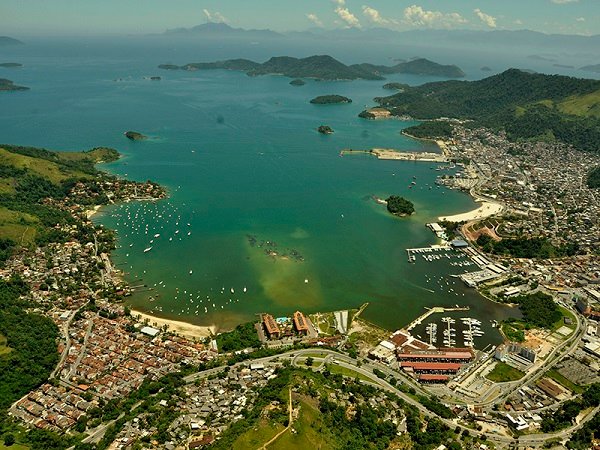SUMMARY
Angra dos Reis, city located in the south of the state of Rio de Janeiro, faces numerous security challenges due to its complex mix of social and economic factors and its geographical layout. Situated between the mountains and the sea, the city faces a continuous threat of armed conflicts, particularly in areas controlled by criminal gangs adjacent to the BR-101 highway. These territorial disputes, primarily between the Red Command (CV) and the Third Pure Command (TCP), replicate those seen in the capital and contribute to the city’s elevated rates of violent crimes. Additionally, persistent issues such as homicides and property crimes are exacerbated by the presence of these criminal factions. Furthermore, Angra’s status as a tourist destination fuels the proliferation of property-related offenses. Despite efforts, crime rates remain high, exhibiting seasonal fluctuations in line with tourism patterns.
This Content Is Only For Subscribers
To unlock this content, subscribe to INTERLIRA Reports.
Historical and Geographical Context
Angra dos Reis is a city located in the south of the state of Rio de Janeiro, known for its natural beauty and its 365 islands. According to IBGE estimates for 2022, it has a population of approximately 167,434 inhabitants. Its current importance is since it hosts the terminal of the Bay of Ilha Grande (TEBIG), a Petrobras facility, located in the Monsuaba neighborhood and the BrasFELS Shipyard located in Jacuecanga. Moreover, it is currently home to the only functioning nuclear power plants in Brazil. Nowadays, due to the beauty of its beaches and surrounding regions, Angra has become a strong tourism spot, not only at the state level but also nationally. It has 97 islands, many owned by national and international celebrities, with the largest one being called Ilha Grande.
Moreover, the city’s location makes it a strategic hub for the distribution and importation of drugs. Angra is close to the first and the second largest consumer markets in the country, São Paulo, and Rio. It is also near the largest port, Santos, and two other important ones, one in Rio and one in Itaguaí. Finally, it is crossed by BR-101, a road that connects almost the entire Brazilian coast on the Atlantic side. Controlling it means having a great alternative for accessing large local markets and for exporting drugs to Europe and Africa.
Despite the efforts of law enforcement, the region faces challenges related to public security, such as drug trafficking and crimes against property and life.

Angra dos Reis is a city whose economy is intrinsically linked to tourism, especially during the summer months, when its beaches and islands attract visitors from all over the country. This seasonality in tourist flow not only boosts local economic activity but also has a direct impact on the region’s crime rates. During the high season months, when the city is full of tourists and commercial activity is in full force, crime rates, such as theft, robberies, and even crimes against life, tend to increase. On the other hand, during the winter months, when the tourist flow decreases significantly, there is a reduction in criminal incidents.
The city is crossed by BR-101, one of the country’s main highways and its main access road. As it crosses the city and connects several neighborhoods, this highway also passes through urban areas that include favelas, such as Sapinhatuba l, ll and lll. These communities are under the control of criminal factions, which creates a series of challenges for local public security.
The presence of criminal factions in the vicinity of the highway significantly increases the risk of violent incidents, such as shootings, whether between rival groups or in clashes with police forces. Furthermore, the proximity of favelas to the highway facilitates the occurrence of robberies and mass robberies, where criminals take advantage of the flow of vehicles to carry out attacks and then flee towards the communities.

Crimes Against Life
One of the main security challenges in Angra dos Reis is the high rate of crimes against life, particularly homicides. According to data from the Public Security Institute (ISP) of the State of Rio de Janeiro, the homicide rate in Angra dos Reis has remained persistently high in recent years, exceeding the state average.
Statistical data from Angra dos Reis between the years 2019 and 2023 reveals that a total of 280 incidents of violent deaths were recorded. This figure includes intentional homicides, femicides, robberies followed by death, and bodily injuries followed by death. Excluding deaths resulting from police violence.
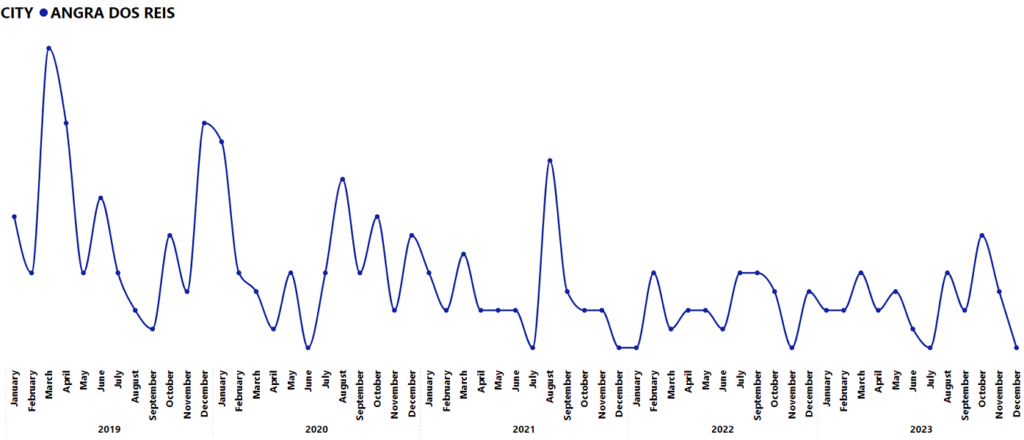
The result is equivalent to an average of 56 cases per year, approximately 5 per month. Considering the city’s population, estimated at 167,434 inhabitants by IBGE in 2022, it results in an average rate of 33.5 per 100,000 inhabitants.
Angra’s 2023 violent death rate was 24.5 per 100,000 inhabitants. Thus, it is quite above the numbers calculated for the capital, for the state, and for the country, respectively 17.1, 21.2, 20, according to data disclosed by the ISP and the Justice and Public Security Ministry.
The last yearly rate demonstrates an improvement compared to the 2019 scenario, when it reached 54 deaths per 100,000 inhabitants. However, it is an increase compared to the previous year, 2022, when it registered 21 per 100,000 inhabitants.
Even though 2022 had a better scenario compared to 2023, it was in this year that Angra dos Reis gained prominence on the list of the 50 most violent cities in Brazil, occupying the 22nd position in the ranking. This data comes from the 17th Brazilian Public Security Yearbook, from 2023.
One of the explanations for this panorama is the expansion of drug trafficking and the resulting disputes between gangs in recent years in the city. It is also important to consider the impact of the Pacifying Police Units (UPPs) program implemented in the city of Rio de Janeiro during preparations for international events such as the 2014 World Cup and the 2016 Summer Olympic Games. The intensification of overt policing in Rio, aimed at pacifying communities, is believed to have contributed to the migration of gangs to small and medium cities in the state of Rio de Janeiro, including Angra dos Reis. Recent public security data revealed that from January 2019 to December 2023, Japuíba is the neighborhood of Angra dos Reis with the highest number of crimes against life with 25 cases, representing 9% of the total cases in the region. Next are Frade, Parque Mambucada, Monsuaba and Bracuí, with 17, 14, 13 and 12 cases, respectively.
Crimes Against Property
In addition to crimes against life, crimes against property represent a significant challenge to security in Angra dos Reis. Robbery, theft, and extortion are common occurrences in the city, impacting both residents and tourists visiting the region. Between January 2019 and December 2023, 4,304 incidents against property were recorded, including robberies, thefts, and extortion. This equates to an average of 861 cases per year, 72 per month, and 3 per day.

The seasonality of property crimes follows the city’s tourist pattern, with a higher incidence in January, the height of summer, and the month of school holidays, and a lower incidence in June, the beginning of winter.
Theft is the most common crime, representing 2,454 incidents between 2019 and 2023, with an average of 491 per year, 41 per month, and 2 per day, corresponding to 20.56% of all criminal records in Angra dos Reis. Then, robbery, i.e. theft with threats and/or violence, is the second most frequent, with 1,103 incidents recorded between 2019 and 2023, an average of 221 per year and 18 per month, representing 9.24% of the city’s total criminal records.

Analyzing the neighborhoods with the most records, we found that Centro leads the list with 660 incidents, followed by Japuíba with 233 cases, Frade with 141 cases, Mambucaba with 131 cases, and Nova Angra with 114 cases. As for the places of occurrence, most cases occurred on public streets, accumulating 1,624 cases or 37.69% of the total, followed by residences (393 cases) and commercial establishments (290 cases).
Property crimes occur throughout the day, with peak incidences observed between 00:00 and 01:00, any day of the week. A second wave can be identified between 9:00 and 12:00, mainly on weekdays (Monday to Friday), followed by a third and less significant wave between 17:00 and 20:00.

Between 2019 and 2023, 303 cases of vehicle theft and 264 cases of vehicle robbery were recorded in Angra dos Reis, resulting in an average of 113 vehicles stolen (theft and robbery) per year in the city. Most of these incidents occurred on public roads, with 415 cases or 73.19% of the total.
The neighborhood with the highest number of incidents was Centro, which recorded 58 incidents, followed by Japuíba with 52 cases, Nova Angra with 24 cases, Balneário with 22 cases, and Camorim with 17 cases. Regarding the times of occurrence, it is observed that vehicle thefts occur most frequently between midnight and 1:00, while vehicle robberies have a higher incidence between 18:00 and 22:00.
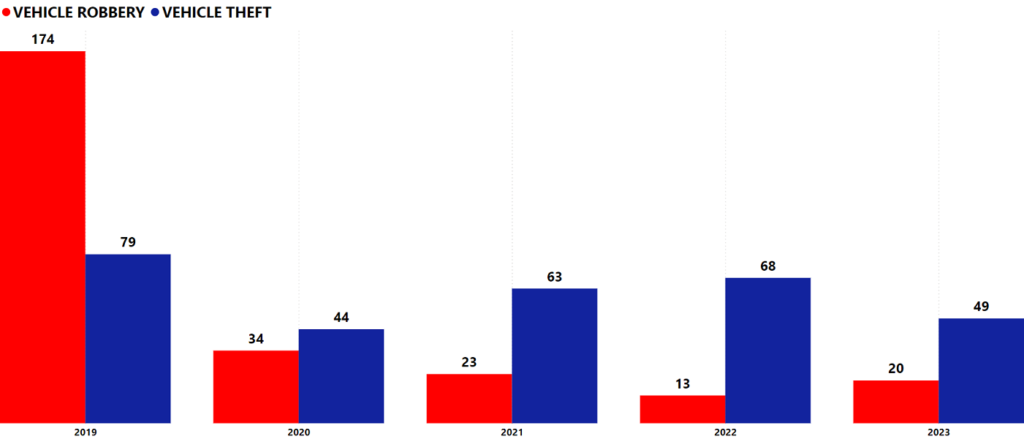
Presence of criminal factions
A crucial element in the dynamics of crime in Angra dos Reis is the presence and dominance of criminal factions in the city’s favelas and poorest communities. These criminal organizations exercise control over drug trafficking and other illicit activities, imposing their authority through violence and intimidation.
The second largest criminal faction in the country, Red Command (CV) originated in 1979 in the extinct Ilha Grande prison, in Angra dos Reis. Although its most important bases are currently in Rio de Janeiro’s favelas, the expansion of the Pacification Police Units (UPPs) encouraged its expansion to the south of the state, especially in the regions of Angra dos Reis and Paraty. In Angra dos Reis, the Red Command dominates most favelas, including Lambicada, Camorim, Morro da Glória (1 and 2), and Sapinhatuba III.
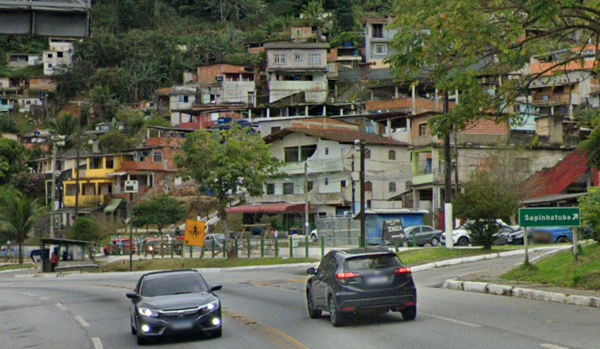
Most of the shootings occur in the Sapinhatuba complex. The constant armed clashes are the result of the proximity between two major rivals. While the CV controls Sapinhatuba III, the Third Pure Command (TCP) gives the orders in Sapinhatuba I and II. The TCP, which disputes territory with the CV mainly in the regions of Volta Redonda, Barra Mansa, Angra dos Reis, and Paraty, maintains ties with the Capital First Command (PCC) and militias. In addition to Sapinhatubas, TCP also controls the Parque Belém and Pereque favelas.
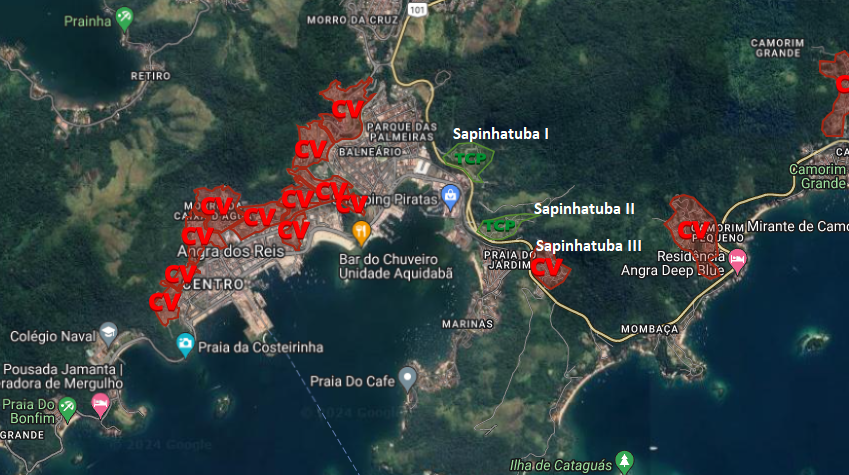
These communities, along with Morro do Moreno, Areal, Parque Belém, and Frade, are located on the banks of the BR-101 highway. This not only makes them havens for criminals who commit crimes on the highway but also exposes drivers to the risk of being hit by gunfire during clashes in one of these communities.
Recently, on 3 March, there was an intense confrontation between drug traffickers from the Sapinhatuba II communities, dominated by the TCP, against Sapinhatuba III, controlled by the CV. The confrontation happened after a criminal known as “7” switched from CV to TCP. According to the police, criminals from Rocinha, favela located in the South Zone of the city of Rio de Janeiro, helped the “Bonde do Feio” linked to the CV to dominate the communities of opponents that are surrounded by areas dominated by the CV.
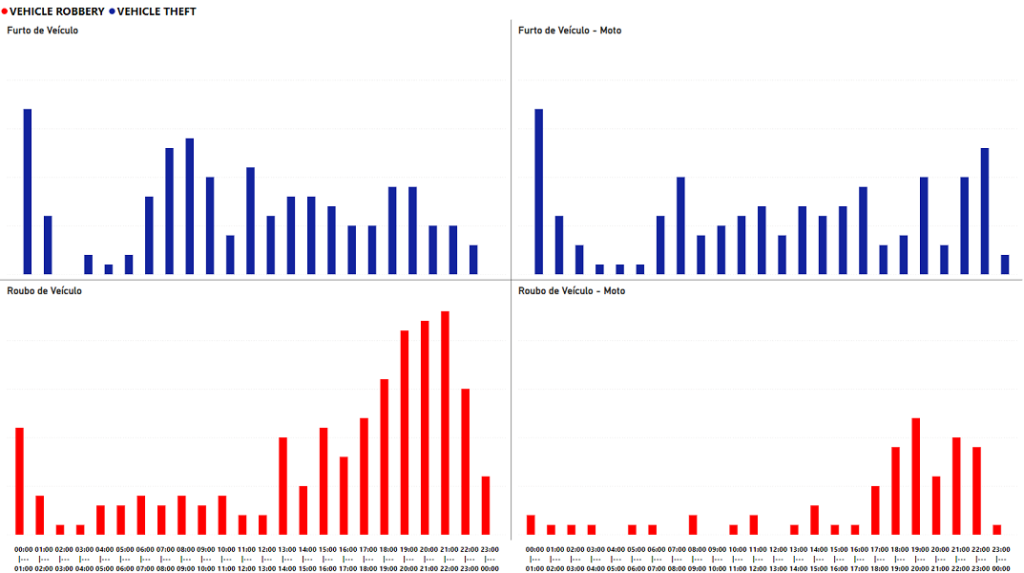
Outlook
Angra dos Reis faces significant challenges concerning its public security, resulting from its complex socioeconomic and geographic dynamics. The most affected neighborhoods, such as Centro, Japuíba, Parque Mambucaba, Frade, and Nova Angra, record a considerable monthly average of criminal incidents.

Although crime rates showed a temporary drop during 2020 due to the COVID-19 pandemic, the numbers rose again after the flexibilization of social isolation, already exceeding the records from 2019, the pre-pandemic period. This suggests that security challenges persist and could even worsen soon, depending on the dynamics of the criminal scenario.
Local wealth and the seasonal influx of tourists are contributing factors to the maintenance of the current state of things because they solidify the city as a consumer market. The money that circulates reinforces the economic means by which the gangs that migrated to Angra must sustain themselves and seek profits. Besides, the current CV expansion in the capital, and even of other groups of criminals, fuels the local fights. On top of that, while the local overloaded security forces maintain as a priority the fight against criminal organizations and drugs and firearms trafficking, minor crimes, like thefts, tend to receive less attention.



